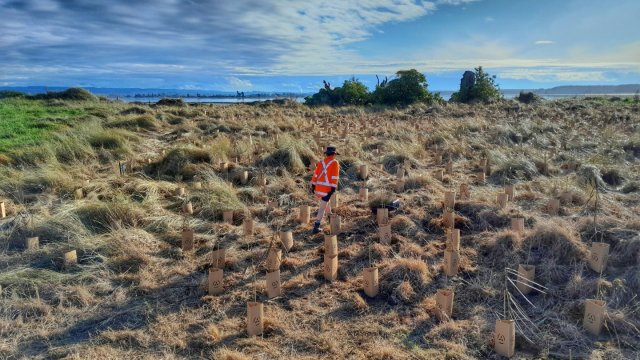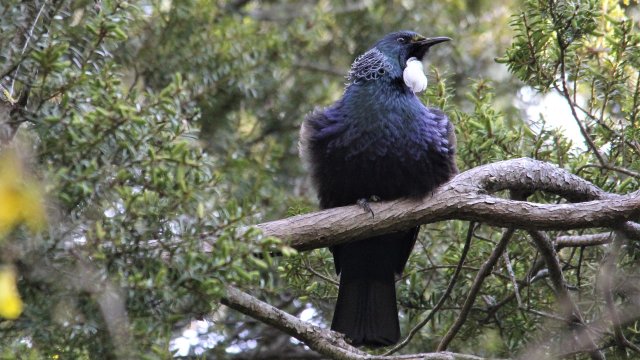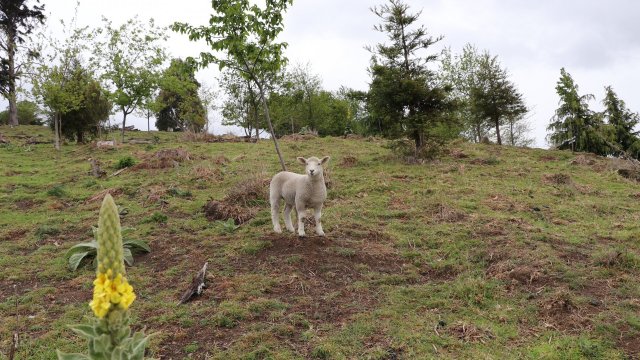Grazing on The Grampians – a long-term vision for a unique reserve
19/10/2020 4:23pmGrazier Andrew Newton has a unique role in Nelson life – guardian to the 80 sheep that now live on the Grampians Reserve.
As a natural method of managing fire risk and controlling non-native plant species, sheep are key players in an Ecological Restoration Plan that aims to make the Grampians a place where indigenous plant and animal life can thrive.
Andrew is always conscious the Grampians is a public space and is amazed at the number of people who regularly use it.
“It is surprising that in a country with 25 million sheep many people never get close to one. Our Wiltshire sheep are not disturbed by passersby, so are well used to being photographed and approached.”
One of the difficulties in managing the Grampians is its proximity to residential properties. Following the 2019 wild fires in Nelson and Tasman, it was clear potentially flammable vegetation presented a fire risk.
Exotic tree plantations, grassland and shrubland on the north-west slopes of the reserve are prone to drying out during hot summer months.
The sheer size of this area means the sole use of herbicide and weed cutters is prohibitively expensive and not effective. Thoughts at Council turned to methods used in the past.
Sheep previously grazed on the Grampians, and it was now time for them to return, as a natural way of managing fire risk, and an innovative method for keeping non-native plants under control.
“Another aspect we saw last year was the fire on the Botanics/Sir Stanley Whitehead area,” says Andrew. “The grazed area contained the fire, which gave firefighters the opportunity to concentrate on keeping people’s residences safe. The sheep keep that risk to a minimum as the new fenced areas focus their efforts on that grazed fire buffer.”
The sheep also have an appetite for old man’s beard and banana passion fruit, which can thrive in the reserve at the expense of native species. Fencing on the Grampians ensures native plant species are unaffected by livestock.
Introducing sheep into a public area requires careful management. Lambs can become ‘mis-mothered’, by following human visitors while their mother is distracted.
“They live the good life with plenty of sun, shelter and shade in summer. The only real risk is the odd dog issue, but most owners are responsible.”
Recent changes to Council’s dog control bylaws mean parts of the Grampians, where sheep graze, are now on-leash areas for dog walkers.
“It was good work by NCC to get signs in place,” says Andrew. “With dog walkers self-regulating, this has improved life for the sheep.”
A haven for native birds, trees and even the at-risk longfin eel, the Grampians Reserve, bordered by Bishopdale to its south and the Brook to its east, is one of those special areas of natural beauty that make Nelson such a rewarding place to live.
Loved by dog walkers, cyclists, foragers and people who just want a walk in nature without straying far from the CBD, the Grampians has a unique set of circumstances that require careful ecological management by Nelson City Council.
These were laid out in 2019 in an Ecological Restoration Plan specifically made for the Grampians. Produced alongside Council staff by ecological consultancy Wildlands, the plan outlines a vision for the reserve to manage the effects of pests (both animal and plant), fire, livestock and erosion.
The goal of the plan was to make the Grampians Reserve a place where indigenous plant and animal life can thrive. From replacing exotic tree plantations with natives, to improving the habitats available to native birds, insects and lizards, Council staff are now stepping up work that will see the Grampians both transformed and protected.
Sports and Recreation Chair Tim Skinner said the work being carried out at the Grampians would protect one of Nelson’s most-loved areas.
“We are so lucky to have an outdoor environment this rich in native animal and plant life just a short walk from our city centre. Council has a responsibility to be careful stewards of this land, and the work that I have witnessed will protect this asset for future Nelsonians to enjoy and take care of themselves.”
But as Group Manager Community Services Roger Ball explains, sheep are not the only way to eradicate pests in our reserves.
“Our overall plan is to let the current native forest thrive. Native forest makes up about 50% of the Grampians reserve – we have mahoe, totara, tarata… one of Nelson’s biggest kahikatea is on the Grampians.
“Weeds like climbing asparagus, old man’s beard, and banana passionfruit can smother native trees if you let them take hold. Once you come across an area with an infestation, it’s about five years' work to get it under control. This is done with a combination of herbicide pastes and manual work – in the first year you focus on the big mature plants, in year two the smaller leftovers and then for the next three years you have to be vigilant with any further growth.”
This work has been part of Council’s responsibilities in our reserves for decades, but in recent years there has been an increased effort to protect native forest. That motivation also extends to native wildlife, an aspect of reserve management that is partially handled by the Birdlife on Grampians volunteer group.
Birdlife on Grampians group coordinator Bryce Buckland says his group of approximately 25 volunteers come from all sorts of different backgrounds, from law to computer engineering.
“We’ve been doing this work for the past 11 years, setting traps for possums, rats, mice, stoats and weasels. Possums are the trickiest to deal with. In winter they tend not to go into the traps. We have to experiment with different lure flavours to see what works – cinnamon, aniseed, peanut oil, peppermint, rose and so on."
Council recently provided Birdlife on Grampians with a $5000 grant through our Environmental Grants Scheme for replacement traps and bait as part of the Nelson Nature Halo Project. Since 2009, the Birdlife group has received three awards from Council for their work in the Grampians. Constantly improving the designs of their traps, they have removed 1,000 possums, 3,500 rats and 93 weasels and stoats from the reserve.
The work on the Grampians is ongoing, with a long-term vision to protect, maintain and improve the reserve for generations of Nelsonians to come. Asked what he would like to see for the area in the next 10 years, Bryce is keen to see how improvements in technology will make the job easier and more environmentally friendly.
“I won’t be there in 10 years,” he says. “But hopefully we will see gene drive technology start to take control with less traps and no toxins needed. That’s the only way we will get anywhere near predator free New Zealand by 2050.”




